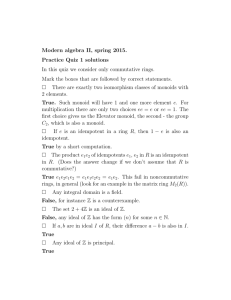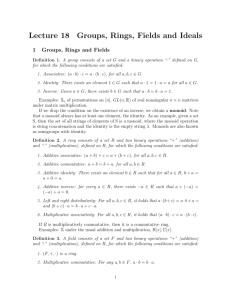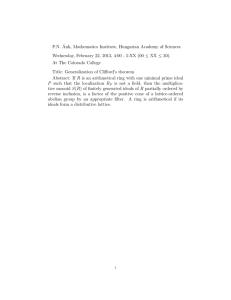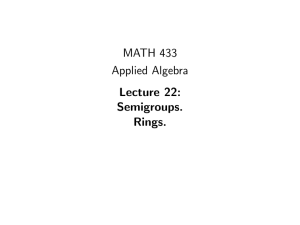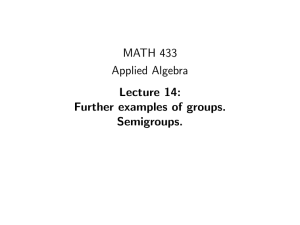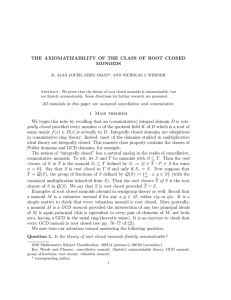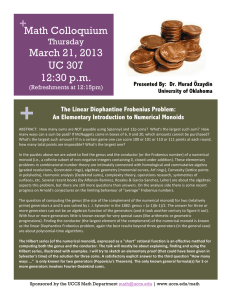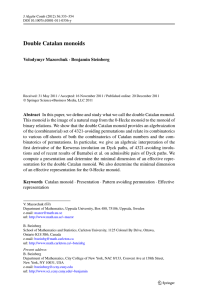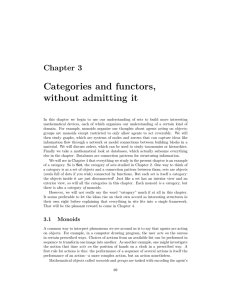A Note on the Commutative Monoids c SHORT NOTE
advertisement
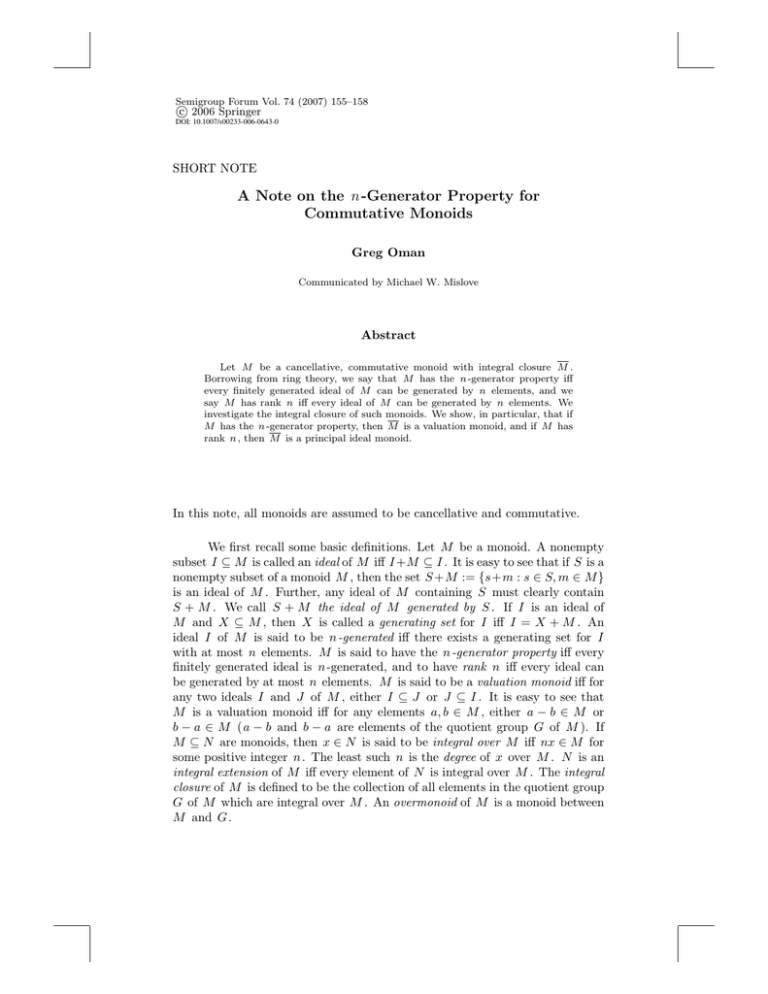
Semigroup Forum Vol. 74 (2007) 155–158
c 2006 Springer
DOI: 10.1007/s00233-006-0643-0
SHORT NOTE
A Note on the n-Generator Property for
Commutative Monoids
Greg Oman
Communicated by Michael W. Mislove
Abstract
Let M be a cancellative, commutative monoid with integral closure M .
Borrowing from ring theory, we say that M has the n -generator property iff
every finitely generated ideal of M can be generated by n elements, and we
say M has rank n iff every ideal of M can be generated by n elements. We
investigate the integral closure of such monoids. We show, in particular, that if
M has the n -generator property, then M is a valuation monoid, and if M has
rank n , then M is a principal ideal monoid.
In this note, all monoids are assumed to be cancellative and commutative.
We first recall some basic definitions. Let M be a monoid. A nonempty
subset I ⊆ M is called an ideal of M iff I +M ⊆ I . It is easy to see that if S is a
nonempty subset of a monoid M , then the set S +M := {s+m : s ∈ S, m ∈ M }
is an ideal of M . Further, any ideal of M containing S must clearly contain
S + M . We call S + M the ideal of M generated by S . If I is an ideal of
M and X ⊆ M , then X is called a generating set for I iff I = X + M . An
ideal I of M is said to be n -generated iff there exists a generating set for I
with at most n elements. M is said to have the n -generator property iff every
finitely generated ideal is n -generated, and to have rank n iff every ideal can
be generated by at most n elements. M is said to be a valuation monoid iff for
any two ideals I and J of M , either I ⊆ J or J ⊆ I . It is easy to see that
M is a valuation monoid iff for any elements a, b ∈ M , either a − b ∈ M or
b − a ∈ M (a − b and b − a are elements of the quotient group G of M ). If
M ⊆ N are monoids, then x ∈ N is said to be integral over M iff nx ∈ M for
some positive integer n . The least such n is the degree of x over M . N is an
integral extension of M iff every element of N is integral over M . The integral
closure of M is defined to be the collection of all elements in the quotient group
G of M which are integral over M . An overmonoid of M is a monoid between
M and G .
156
Oman
We begin with two trivial but useful lemmas:
Lemma 1.
Let I be an n -generated ideal of the monoid M . If X is
any generating set for I , then there exist x1 , . . . , xn ∈ X such that I =
{x1 , . . . , xn } + M .
Proof.
Suppose that I can be n -generated, and let X be any generating
set for I . Let i1 , . . . , in be a set of generators for I . Then since X generates
I , we have that for each k : 1 ≤ k ≤ n , there exist xk ∈ X and mk ∈ M
with ik = xk + mk . We claim that I = {x1 , . . . , xn } + M . To see this, let
y ∈ I be arbitrary. Then since i1 , . . . , in generate I , we have that y = ik + m
for some k and for some m ∈ M . But we have that ik = xk + mk , and so
we get y = xk + (mk + m) . Hence y ∈ {x1 , . . . , xn } + M and the proof is
complete.
Lemma 2.
Let M be a monoid. Then M has the n -generator property iff
for every collection {m1 , . . . , mn+1 } of elements of M , there exist i = j such
that mi − mj ∈ M .
Proof.
Suppose first that the monoid M has the n -generator property.
Consider elements m1 , . . . , mn+1 of M . Let I be the ideal of M generated
by these elements. Then since M has the n -generator property, it follows from
Lemma 1 that there exist n elements from {m1 , . . . , mn+1 } that generate I .
We may suppose (relabelling if necessary) that these elements are m1 , . . . , mn .
Then in particular, we have that mn+1 ∈ {m1 , . . . , mn }+M . Thus mn+1 −mi ∈
M for some i.
The converse follows easily from the condition on M .
Theorem 1.
Let M be a monoid with the n -generator property with integral
closure M . Then:
(1) Every overmonoid of M has the n -generator property.
(2) If a, b ∈ M , then there exists a positive integer k ≤ n such that either
k(a − b) ∈ M or k(b − a) ∈ M .
(3) Every element of M has degree ≤ n over M .
(4) M is a valuation monoid.
(5) M is a bounded integral extension of a valuation monoid.
Proof.
(1) Let S be an overmonoid of M . Consider elements a1 − b1 , . . . ,
an+1 − bn+1 ∈ S , where each ai , bi ∈ M . Let x := b1 + · · · + bn+1 . Then note
trivially that for each i, ai −bi +x ∈ M . Since M has the n -generator property,
it follows from Lemma 2 that there exist i = j with (ai −bi +x)−(aj −bj +x) ∈
M . But then (ai −bi )−(aj −bj ) ∈ M ⊆ S . By Lemma 2, S has the n -generator
property.
Oman
157
(2) Let a and b be arbitrary elements of M . Consider the set {ia + (n −
i)b : 0 ≤ i ≤ n} . Then by Lemma 2, there exist i = j with (ia+(n−i)b)−(ja+
(n − j)b) ∈ M . Simplifying this expression yields that (i − j)a + (j − i)b ∈ M .
If i > j , then (i − j)(a − b) ∈ M , and if j > i, then (j − i)(b − a) ∈ M . This
completes the proof of (2).
(3) Consider an element a − b of the integral closure of M , say of degree
r . By (2), there exists a positive integer k ≤ n such that either k(a − b) ∈ M or
k(b−a) ∈ M . Now if k(a−b) ∈ M then clearly a−b has degree ≤ n . Otherwise
k(b − a) ∈ M . Suppose by way of contradiction that r > n . Then we have that
r(a − b) ∈ M and k(b − a) ∈ M . But this implies that (r − k)(a − b) ∈ M . This
contradicts that a − b is of degree r over M and completes the proof of (3).
(4) By (1), M has the n -generator property. Let a, b ∈ M . By (2), there
exists a positive integer k such that either k(a − b) ∈ M or k(b − a) ∈ M . As
M is integrally closed, we get that a − b ∈ M or b − a ∈ M , and thus M is a
valuation monoid.
(5) By (3), we have that n!M ⊆ M . As n!M ∼
= M , we see from (4) that
n!M is a valuation monoid. It is trivial that every element of M is of degree
≤ n! over n!M .
Next we prove a similar theorem for rank n monoids:
Theorem 2.
Let M be a rank n monoid. Then the integral closure M of
M is a principal ideal monoid.
Proof.
Let I be any ideal of M . We show that I is n -generated. As M
has the n -generator property, it follows from (3) of Theorem 1 that n!I ⊆ M .
Let I be the ideal of M generated by n!I . Then as M has rank n , it follows
that I can be generated by n elements. By Lemma 1, we see that I =
{n!i1 , . . . , n!in }+M for some i1 , . . . , in ∈ I . We claim that I = {i1 , . . . , in }+M .
To see this, let i ∈ I . Then n!i ∈ I . Hence we see that n!i = n!ik + m for
some k and some m ∈ M . But then n!(i − ik ) ∈ M ⊆ M . As M is integrally
closed, it follows that i − ik ∈ M , and so i = ik + x for some x ∈ M . This
shows that I is n -generated.
We’ve shown that M has rank n . But by (4) of Theorem 1, we have that
M is a valuation monoid. It is easy to see that every finitely generated ideal of
a valuation monoid is principal (it suffices by induction to show that every ideal
generated by two elements is principal, and this verification is trivial). As every
ideal of M is finitely generated, it follows that M is a principal ideal monoid.
This completes the proof.
There is a fairly extensive literature on the ideal theory of commutative
monoids. The interested reader is encouraged to consult the bibliography of [1]
or [2] for a long list of references on this topic.
158
Oman
References
[1] Anderson, D. D. and E. W. Johnson, Ideal theory in commutative semigroups, Semigroup Forum 30 (1984), 127–158.
[2] Halter-Koch, F., “Ideal Systems”, Dekker, New York, 1998.
[3] Gilmer, R., “Multiplicative Ideal Theory”, Queen’s Papers in Pure and
Applied Mathematics, Kingston, 1992.
Department of Mathematics
The Ohio State University
231 W. 18th Ave.
Columbus, OH 43210
USA
oman@math.ohio-state.edu
Received June 3, 2005
and in final form June 30, 2006
Online publication December 20, 2006
